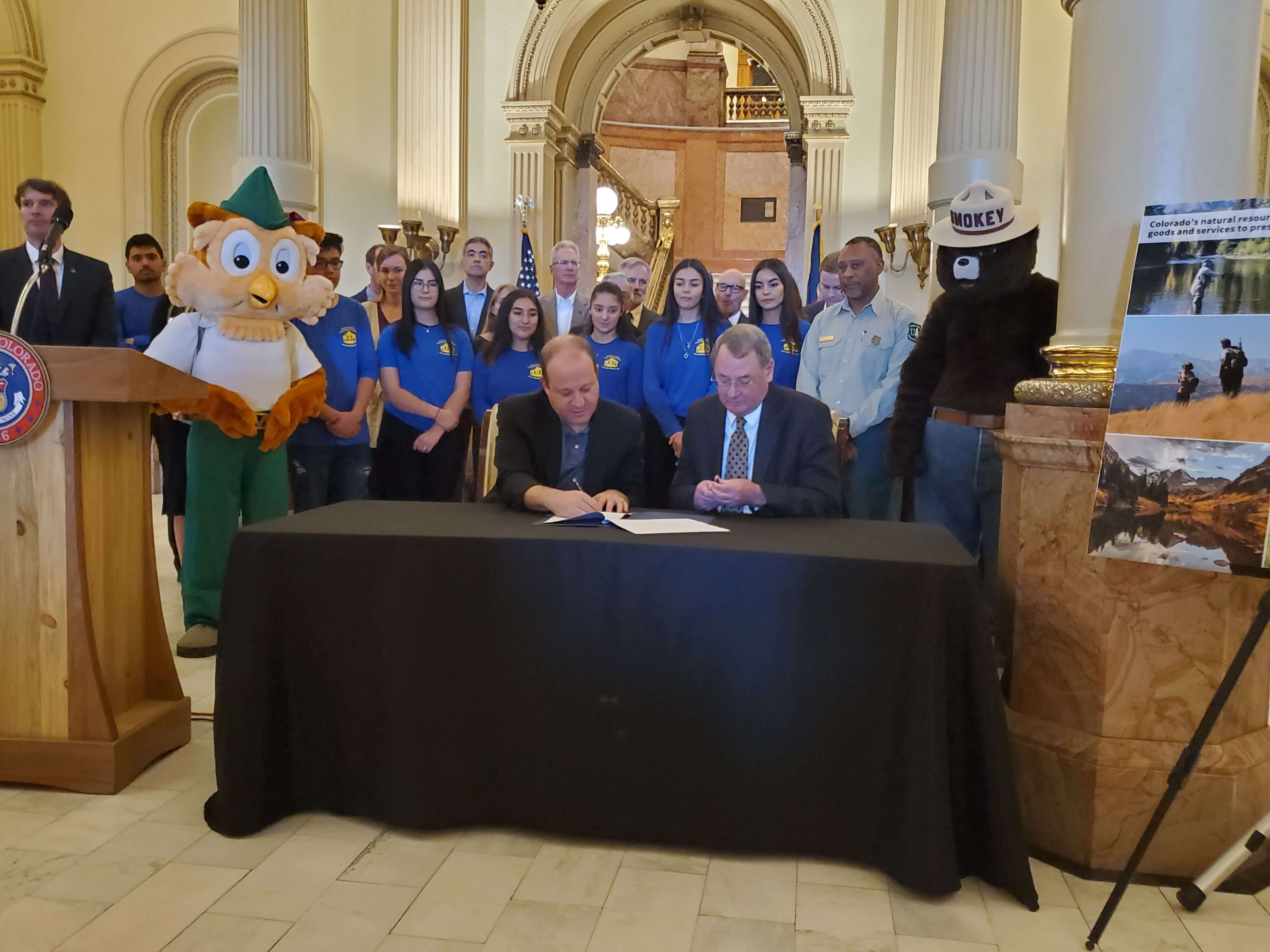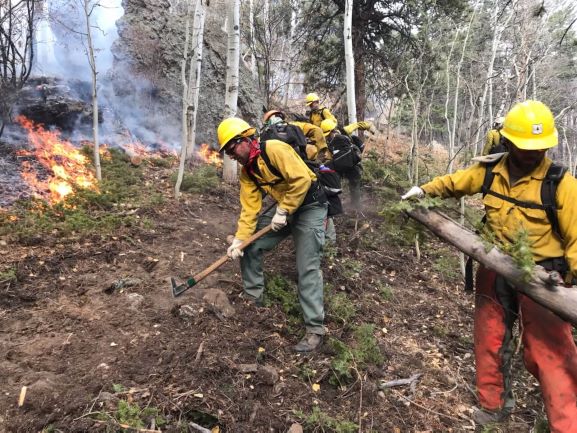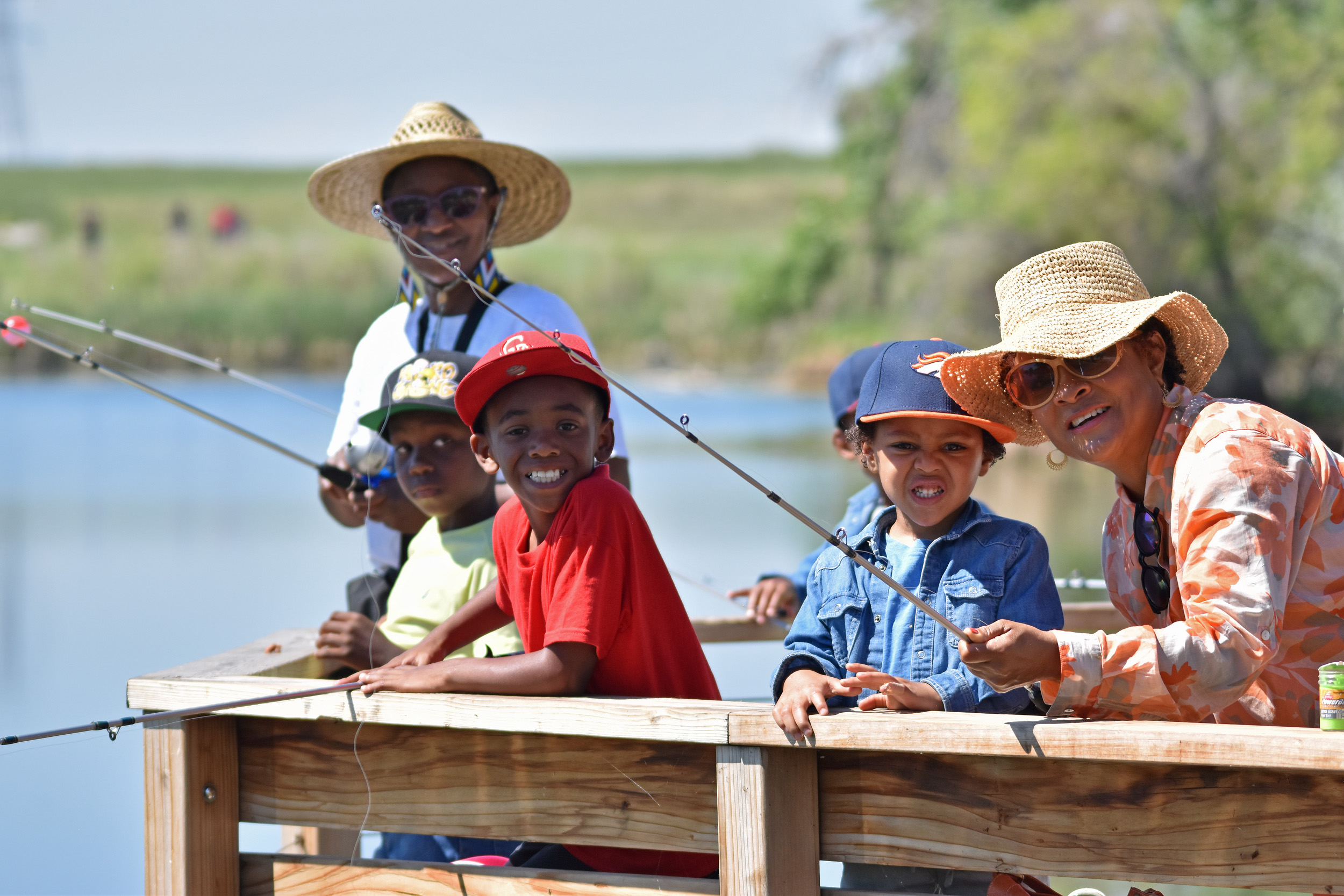
Shared Stewardship in Colorado
Shared Stewardship in Colorado
Colorado’s forest landscapes and watersheds face increasing challenges. Overly dense forests, fire suppression, widespread insect and disease impacts, population growth, and climate change all increase wildfire risk and impact forest health and recreation opportunities. Shared Stewardship brings together national, regional, state, tribal, and local governments and stakeholders to plan together, prioritize together, and act together.
In 2018, the U.S. Department of Agriculture’s U.S. Forest Service released its national Shared Stewardship strategy outlining three core elements:
In a Shared Stewardship approach, the USDA Forest Service seeks to share decision space with state and tribal foresters and other partners to determine land management needs at the state and tribal level.
A Shared Stewardship agreement was formalized in Colorado in 2019 when the U.S. Department of Agriculture (which includes the U.S. Forest Service) and the State of Colorado signed a memorandum of understanding (MOU) to establish a Shared Stewardship framework for all lands in the state. In 2024, a ten year extension to the MOU was signed. DNR is working with partners at the Colorado State Forest Service, Division of Fire Prevention and Control, Bureau of Land Management, and others, to advance Shared Stewardship in Colorado.
Accommodation Statement: The State of Colorado is committed to providing equitable access to our services to all Coloradans. Please contact Lauren Beecher (lauren.beecher@state.co.us or 720-682-8330) for personalized accessibility assistance using the map below. We will contact you directly within three business days. Visit our accessibility webpage for more information and services, including AIRA, our free service for blind and low-vision users.
Frequently Asked Questions
Colorado's forest landscapes and watersheds face increasing challenges. Overly dense forests, fire suppression, widespread insect and disease impacts, population growth and climate change all pose unprecedented threats and contribute to increasing wildfire risk. Increased use impacts recreation infrastructure and wildlife. We must manage Colorado's forests at much larger scales to meaningfully address these challenges. Shared Stewardship brings together national, regional, state, tribal and local players to plan together, prioritize together, and act together.
In 2018, the U.S. Department of Agriculture's U.S. Forest Service released its national Shared Stewardship strategy outlining three core elements:
- Determine management needs on a state level
- Do the right work in the right places at the right scale
- Use all available tools for active management
In a Shared Stewardship approach, the USDA Forest Service seeks to share decision space with state and tribal foresters and other partners to determine land management needs at the state and tribal level.
Shared Stewardship priorities are those agreed upon by Colorado and the USDA Forest Service.
A Shared Stewardship agreement was formalized in Colorado in 2019 when the U.S. Department of Agriculture (which includes the U.S. Forest Service) and the State of Colorado signed a memorandum of understanding (MOU) to establish a Shared Stewardship framework for all lands in the state. In 2024, a ten year extension to the MOU was signed.
In 2019, the state of Colorado's Department of Natural Resources (DNR) worked with the Governor's Office and the USDA Forest Service (Rocky Mountain Region) to craft an agreement reflecting the diverse priorities of Coloradans. This mutual agreement resulted in the Memorandum of Understanding (MOU) between the State of Colorado and the U.S. Department of Agriculture.
DNR leadership pushed to include diverse groups and values. Therefore, the Colorado Shared Stewardship MOU broadly focuses on managing Colorado's forests for ecological restoration, recreation, protecting water resources and infrastructure, conserving fish and wildlife, engaging diverse stakeholders, and promoting healthy and safe communities.
After signing the Shared Stewardship MOU in October 2019, Colorado officials and the USDA Forest Service began meeting in February 2020 to chart a path forward. The group — referred to as MOU Partners — includes the U.S. Department of Agriculture's U.S. Forest Service, Colorado's Department of Natural Resources, as well as the Colorado State Forest Service (CSFS). The Partners are bound by these principles:
- Science: Determine availability of data, maps and analyses.
- Tools: Use all available authorities, programs and tools.
- Models: Select appropriate models for prioritizing and decision-making.
- Strategies and Plans: Use existing plans as a foundation.
- Resources: Evaluate and deploy all available resources.
- Relationships: Work in partnership with other federal agencies, state agencies, tribal governments, local governments, private landowners and non-governmental organizations.
- Innovation and Public Engagement: Maintain customer focus and embrace new partnerships.
The strength of the MOU lies with diverse partners working toward shared goals. While the Shared Stewardship agreement was signed by Governor Jared Polis and U.S. Secretary of Agriculture Sonny Perdue, the MOU explicitly directs their respective agencies to involve tribal and local governments, other federal agencies and non-governmental organizations in the implementation and oversight of Shared Stewardship in Colorado. Therefore, partners will be engaged in identifying priority landscapes, designing and implementing activities, and monitoring and evaluating outcomes.
Colorado is fortunate to have many active forest and watershed collaborative groups already engaged in cross-boundary Shared Stewardship work. Collaborative groups have leveraged federal and non-federal resources through the Collaborative Forest Landscape Restoration Program (CFLRP), the Joint Chiefs' Restoration Partnership, Forests to Faucets, Good Neighbor Authority, Forest Restoration and Wildfire Risk Mitigation (FRWMRM), Colorado Strategic Wildfire Action Program (COSWAP), and other programs.
Implementing Colorado's Shared Stewardship MOU will not replace this ongoing work. Rather, the MOU amplifies efforts already occurring in Colorado. The Department of Natural Resources, Colorado State Forest Service, and U.S. Forest Service work together - and with partner organizations - to improve coordination at a state-level. We will make joint decisions to invest our resources where they can do the most to reduce wildfire risk, protect water resources, improve wildlife habitat and recreation opportunities, and ensure that forests continue to contribute to a high quality of life in the state.
Colorado's Shared Stewardship MOU emphasizes new tools to build on existing efforts, including:
- Using the latest science, technology, resources and all active management tools, including the right kind of fire;
- Focusing work on broad outcomes rather than local outputs; and
- Capitalizing on the authorities created by recent legislation.
The Rocky Mountain Restoration Initiative (RMRI) was born when Colorado was selected as a pilot location by the National Wild Turkey Federation and the USDA Forest Service to showcase the USDA's Shared Stewardship Strategy. RMRI is a national effort co-convened by the National Wild Turkey Federation, and the U.S. Forest Service, and a variety of state and local partners to increase the pace of landscape scale forest restoration in the Rocky Mountain West. The Rocky Mountain Restoration Initiative is an example of shared stewardship in Colorado, but does not represent the entirety of shared stewardship in the state. RMRI is included in Colorado's Shared Stewardship Work Plan, and provides examples of strategies for working across jurisdictional boundaries with government and non-government partners to scale forest restoration treatments and measure landscape level outcomes.
In 2022, the Colorado Strategic Wildfire Action Program (COSWAP) was created to accelerate wildfire mitigation and forest health treatments on all land ownerships in Colorado. COSWAP included the three RMRI focal areas as part of their ten strategic focus areas. Since 2022, COSWAP has invested $12 million in RMRI focal areas.
Shared Stewardship empowers Colorado and all its partners and their existing assessments. DNR, USFS and CSFS will consider relevant existing plans, assessments, and agreements for incorporation into a state-level prioritization process, including Colorado's 2020 Forest Action Plan. The partners will also seek stakeholder feedback on incorporating additional resources. Appendix A of the MOU contains a list of some of the types of assessments and plans that are considered.
Shared Stewardship provides the structure to combine funding sources toward the right work in the right place at the right scale based on collaborative input. By prioritizing and planning work together, there is an opportunity to take advantage of shared resources and economies of scale to treat more acres with limited funding dollars. Existing authorities, programs, and funding streams can be leveraged to strategically direct investments. By combining and leveraging resources, staff and funding, we achieve shared goals across boundaries.
Shared Stewardship aims to engage all forest landowners in Colorado in collaborative forest management. Colorado State Forest Service and the U.S. Forest Service will continue to provide technical and funding support to help private landowners sustainably manage their forestlands, and will identify opportunities to enhance this support. Private landowners will be engaged in landscape-scale forest management efforts to improve forest health across ownership boundaries.
Private landowners are eligible for a variety of state and federal resources, including:
- Colorado State Forest Service’s Programs for Homeowners and Landowners
- Colorado State Forest Service's Grants and Funding
- U.S. Forest Service's Landowner Resources
- National Resource Conservation Service's (NRCS) Funding Opportunities
- Colorado Strategic Wildfire Action Program (COSWAP)
After signing the Shared Stewardship MOU in October 2019, Colorado agency staff and the U.S. Forest Service began meeting to chart our path forward, and continues to meet on a regular basis to advance shared stewardship efforts.
The Rocky Mountain Restoration Initiative (RMRI) is an excellent example of shared stewardship in action. RMRI staff posts monthly news on their website. Regional and local forest and watershed collaboratives are also telling their story. The Colorado Forest Collaboratives Network has a dedicated webpage showing collaboratives in Colorado.
Shared Stewardship focuses work on broad outcomes. It does not offer a one-size-fits-all metric for success, but empowers partners and stakeholders to identify desired outcomes and the key performance indicators for measuring them.
The Colorado Shared Stewardship MOU identifies seven key elements of Shared Stewardship in the state:
- Ecological restoration
- Sustainable recreation opportunities
- Sustainable recreation amenities
- Protection of water resources and critical infrastructure
- Conservation of fish and wildlife
- Inclusion of diverse populations
- Healthy communities and vibrant economies
These elements will guide how to evaluate the successes of Shared Stewardship in Colorado. For example: Are we reducing wildfire risk near communities, water resources and critical infrastructure? Is recreation sustainable and contributing to quality of life and economic activity in the state?
Processes to monitor and evaluate outcomes will evolve as planning and execution unfolds across Colorado, but these types of questions will guide work across the expanding network of collaborative projects.



